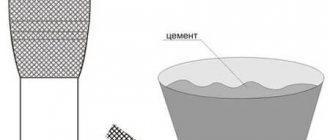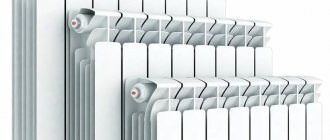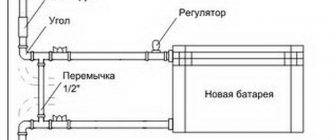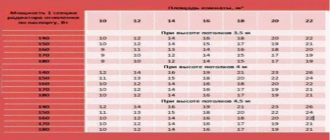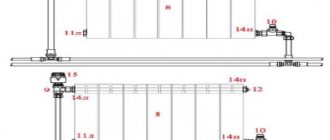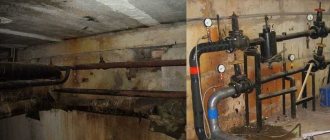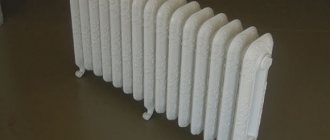Calculation by area
This is the simplest option for determining a more or less exact amount of heat required for heating. When calculating, the main starting point is the area of the apartment or house where heating is organized.
The area of each room is available in the apartment plan, and to calculate specific values for heat consumption, SNiP comes to the rescue:
- For the average climate zone, the norm for a residential premises is defined as 70-100 W/1 m2.
- If the temperature in the region drops below -60 degrees, the heating level of each 1 m2 must be increased to 150-220 W.
To calculate panel heating radiators by area, in addition to the given standards, you can use a calculator. The power of each heating device must be taken into account. It is better not to allow significant overexpenditures, because... As the resulting power increases, the number of batteries in the system also increases. In the case of central heating, such situations are not critical: there, each family pays only a fixed cost.
It’s a completely different matter in autonomous heating systems, where the consequence of any overconsumption is an increase in payment for the volume of coolant and the operation of the circuit. It is impractical to spend extra money, because... Over the course of a full heating season, a decent amount can accrue. By using a calculator to determine exactly how much heat is needed for each room, it is easy to find out how many sections to purchase.
For simplicity, each heating device indicates the amount of heat it produces. These parameters are usually contained in the accompanying documentation. The arithmetic here is simple: after determining the amount of heat, the resulting figure must be divided by the battery power. The result obtained after these simple operations is the number of sections required to replenish heat leaks in winter.
For clarity, it is better to look at a simple example: let’s say that you need only 1600 Watts, with the area of each section being 170 Watts. Further actions: the total value of 1600 is divided by 170. It turns out that you need to purchase 9.5 sections. Rounding can be done in any direction, at the discretion of the home owner. If there are additional heat sources in the room (for example, a stove), then you need to round down.
The opposite direction is calculated if the room has balconies or spacious windows. The same applies to corner rooms, or if the walls are poorly insulated. The calculation is very simple: the main thing is not to forget about the height of the ceilings, because... it is not always standard. The type of building material used to construct the building and the type of window blocks also matter. Therefore, the data for calculating the power of steel heating radiators should be taken as approximate. The calculator is much more convenient in this regard, because... it provides for adjustments to building materials and premises characteristics.
Features of tubular batteries
Due to their higher cost, tubular steel batteries are used much less frequently than panel batteries. The design consists of several rows of parallel tubes. In this case, the rows can be located not only horizontally or vertically, but also at an angle.
Characteristics of tubular instruments
Although the operating principle is identical, the methods for manufacturing tubular equipment vary. Some are made in the form of sections, similar to cast iron, which are joined by welding. For others, steel rows of tubes are used, connected at the bottom and top by manifolds.
Although the design of tubular radiators varies, almost all models have similar characteristics. This equipment is optimally suited for installation in heating systems in low-rise buildings.
The heat transfer of tubular radiators, compared to panel-type analogues, is greater, but the price is much higher.
How to adjust preliminary indicators
Approximate values definitely need clarification. To obtain a more accurate result, you will need to take into account all factors.
Each of them can provoke an increase or decrease in heat loss:
- Material for walls.
- Thermal insulation efficiency.
- Area of window units and type of glazing.
- Number of external walls.
High-quality calculators are equipped with special coefficients that take these factors into account. All that is required to more accurately align the preliminary heat loss indicators is to multiply them by these coefficients.
Window
Most often, it is these structural elements that become the culprits of leakage from 14 to 30% of heat. For a more accurate calculation, you need to take into account their size and level of insulation. This explains the presence of two calculated coefficients.
Ratio of window area to floor area:
- 10% — 0,8
- 20% — 0,9
- 30% — 1,0
- 40% — 1,1
- 50% — 1.2
The last number is the coefficient.
Type of double glazed windows:
- Three-chamber - 0.85.
- Double-chamber - 1.0.
- Wooden double frames - 1.27 or 1.3.
When considering walls and roofing, the type of material and insulation is taken into account: therefore, there are also two coefficients.
Insulation:
- A brick wall of normal thickness is used as a basis. The coefficient is equal to one.
- For small thicknesses, the coefficient is taken as 1.27.
- Well-insulated structures with a thermal insulation thickness of at least 10 cm: correction number 0.8.
Calculating the volume of the radiator
So, all that remains is to determine the volume of water in the heating radiator. What's the easiest way to do this? We again recommend using tables. Please note that manufacturers offer various models of heating devices on the market. The model line may include radiators not only of different designs, but also of different sizes. In terms of the size range, it is based on the interaxle distance, that is, this is the distance between the axes of two collectors (upper and lower). In addition, manufacturers currently offer custom-made devices that use individual sketches and drawings. Determining the capacity of these batteries is much more complicated.
But let's return to this indicator and show the average values for heating appliances. We take models of type 500 (center distance).
Technical characteristics of cast iron radiators
- Cast iron radiator ChM-140 of the old model - 1.7 liters volume of one section.
- The same thing, only a new sample - 1l.
- Steel panel device type 11 (that is, one panel) – 0.25 liters for every 10 cm of device length. Measuring the type in quantitative terms increases the volume of coolant by 0.25 liters. That is, type 22 - 0.5 l, type 33 - 0.75 l.
- Aluminum battery – 0.45 l per section.
- Bimetallic – 0.25 l.
This list does not include steel tubular radiators. Even the approximate volume of this model will not be easy to determine. The thing is that manufacturers use pipes of various diameters for their production, hence the impossibility of choosing at least an average option. Therefore, we recommend paying attention to the passport data, where the volume indicator should be indicated.
How are steel radiators calculated?
Panel-type steel batteries are considered a novelty in the field of heating household appliances. Their feature is their more compact dimensions. The heat transfer of steel radiators is an order of magnitude higher compared to conventional sectional radiators with batteries. The structure may include several corrugated metal panels (1,2 or 3 pieces). Panels refer to the plates through which coolant enters the system. Before you calculate panel radiators by power, you need to arm yourself with information about the main types of these devices.
Data from the power table of steel heating radiators:
- Three-panel. The massiveness of the devices is explained by the presence of 3 panels equipped with fins. Marked 33.
- Double panel. The number of plates has been reduced to two. Marking - 22.
- Double panel plus one plate (21).
- Single panel with one plate. They are characterized by low power, light weight and compact dimensions (11).
- Only panel without fins (10).
The power of such devices is also calculated by area, but they are based not on a square meter, but on a cubic meter.
SNiP requirements:
- In brick houses, 34 watts are required per 1 m3.
- In panel buildings, 41 watts are required per 1 m3.
Keeping these standards in mind, you can calculate any room. Knowing the height of the ceilings is a must.
Calculation example:
The panel building has dimensions of 3.2 by 3.5 meters, with a ceiling height of 3 m. To determine the volume, you need to multiply 3.2, 3.5 and 3: the result is 33.6 m3. This figure is multiplied by the coefficient for a panel house (41). The result is 1378 W. To obtain the most accurate value, use a calculation table for steel heating radiators. It displays information on each climate zone and object characteristics.
Recalculation of panel radiator power depending on temperature conditions
But the values in this table are valid for a system with parameters 75/65/20 (supply temperature 70°C, return temperature 65°C, room temperature maintained at 20°C). Based on these values, the temperature delta is calculated: (75+65)/2-20=50°C.
If your system parameters are different, recalculation is necessary. For such cases, Kermi has compiled a table with correction factors.
Conversion table depending on heating system temperatures (click to enlarge)
Let us assume a low-temperature system with parameters 60/50/22 (supply temperature 60°C, return temperature 50°C, room temperature maintained at 22°C). We calculate the temperature delta: (60+50)/2-22=33°C. We find a line in the table with the temperature of the supplied water, then with the temperature of the discharged water and reach the value of the room temperature (22°C in our case). This cell has a coefficient of 1.73 (marked in green).
We multiply the calculated amount of heat loss for our room by it: 2150W*1.73=3719.5W. Now we are looking for suitable options in the power table for this case (marked in green). The choice is more modest, but radiators are also required much more powerful.
Here is the entire method for determining the power of panel radiators. Using it you can choose steel panel batteries for any room and any system.
You may be interested in reading about how to calculate the power of a boiler and how to determine the diameter of heating pipes.


